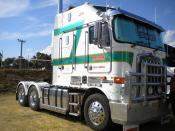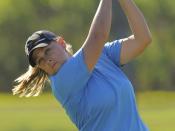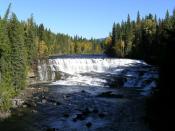1.0 Introduction
This report will biomechanically analyse the golf swing of three students. From this analysis, I will rank the students for the distance and accuracy attainable from their swings. Following this will be a biomechanical and an anatomical justification explaining the reasons for these rankings. I will then draw a conclusion highlighting the important factors and correct techniques required for an accurate and distant golf drive.
2.0 Biomechanical Analysis
2.1 Golfer 1- Andrea Graham
Golfer 1, Andrea Graham, fails to include all eight phases of her golfing drive (refer appendix D) thus minimising the acceleration in her downswing. This occurs because she does not provide optimal range of motion for the club to gain maximum possible velocity before impact. Graham's force summation and timing (Teachers notes: 2003) is also affecting her drive. In the backswing phase (refer appendix D), her knees remain fixed and her pelvis rigid, therefore not transferring weight, which produces a myriad of related errors.
Because her pelvis stays in the same position (refer appendix B), her shoulders and kinetic power that can be generated from the pelvis are lost. In the early phases of Graham's golf swing, her lever action (Teachers notes: 2003) is naturally shortened by the premature flexion of her elbows. Because of this, the swing does not extend to a full arc thus creating a loss of speed and power in the swing. Because she is unable to swing at the ball with maximum power, her connection is 'unclean', which in turn affects the flight of the ball.
2.2 Golfer 2- Jason Rawlings
Golfer 2, Jason Rawlings, allowed for excellent, if not perfect, weight transferral through optimal flexion of his left and leading leg. Throughout his swing, Rawlings maintains the longest possible lever by minimising excess flexion of his elbows. These...



Good Job!
Very well done. Sounds like something straight out of TGM. (The Golfing Machine)
2 out of 3 people found this comment useful.